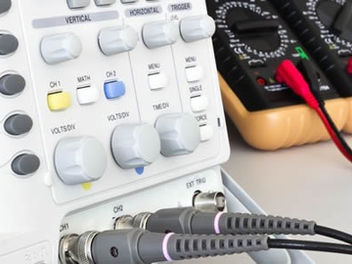What Happens If EICR Fails?
- Guy hudson
- Dec 11, 2023
- 5 min read
Electrical systems form the unassuming backbone of our contemporary world, seamlessly powering our homes, workplaces, and industries. Yet, concealed within the intricate web of wires and circuits lies the latent potential for hazards that could disrupt daily life and compromise safety. Amidst this unseen network, Electrical Installation Condition Reports (EICRs) emerge as sentinels safeguarding electrical safety.
EICRs, administered by adept and qualified electricians, serve as pivotal evaluations of electrical installations, ensuring adherence to stringent safety standards. These reports delve into the very essence of an Electrical Installation's condition, meticulously examining its structural integrity and compliance. They unveil the intricate balance between functionality and safety, outlining potential hazards that could otherwise lurk unnoticed within these vital systems.
In this discourse, we unravel the profound implications of an Unsatisfactory EICR, a telling verdict that unveils lurking threats within an Electrical Installation. Beyond the façade of these wires and conduits, an Unsatisfactory EICR signifies underlying issues demanding immediate attention and remedial work.
A Failed EICR
Before delving into the implications, let's understand what constitutes a failed EICR. An EICR can be deemed unsuccessful when electrical testing reveals significant issues or breaches in safety standards. These issues could range from faulty wiring and inadequate insulation to outdated components, posing potential hazards.
Identification of Common Reasons for EICR Failure
Uncovering the reasons behind a failed Electrical Installation Condition Report (EICR) involves delving into a spectrum of common issues that may compromise the safety and functionality of electrical installations. Frequently asked questions about EICRs orbit around these critical points. One prevalent issue contributing to EICR failure is outdated wiring, where ageing electrical systems become susceptible to wear, tear, and potential hazards, such as insulation deterioration or wire damage due to prolonged use.
Inadequate earthing is another common culprit behind failed EICRs. Insufficient grounding can lead to electrical imbalances, increasing the risk of electric shocks or fires. This might arise from poor connections between wiring and grounding points, hindering the effective dissipation of excess electrical energy.
Non-compliance with current safety standards emerges as a significant factor in EICR failures. With regulations and standards evolving to meet contemporary safety demands, installations that do not align with these updated benchmarks face the likelihood of failing an EICR. Elements like obsolete components or improper circuit configurations can contribute to non-compliance, triggering a failed assessment. Property owners and tenants play a pivotal role in this process, necessitating a proactive understanding of these factors. This awareness empowers them to take preemptive measures, such as upgrading outdated wiring, enhancing earthing systems, and ensuring overall compliance with the latest safety standards. By staying informed about these common reasons for EICR failure, property stakeholders can actively contribute to the creation of a safer and more secure living or working environment.
Implications of a Failed EICR
A failed EICR uncovers a spectrum of potential hazards lurking within an electrical installation. These hazards pose tangible risks, ranging from electrical shocks to devastating fires, capable of causing harm or damage to both property and lives. Identification of these hazards through a failed EICR serves as a critical warning sign, demanding immediate attention and remedial action to eliminate the looming threats. Ignoring these warnings could lead to dire consequences, amplifying the likelihood of accidents that not only endanger occupants but also compromise the structural integrity of the property itself.
Beyond the immediate dangers, the legal and safety implications stemming from a failed EICR are weighty. Property owners and tenants shoulder a significant responsibility for maintaining a safe living or working environment. Failure to address identified issues not only violates legal obligations but also jeopardises the well-being of those within the premises. It sets off a chain reaction of potential penalties, fines, and in severe cases, rendering the property uninhabitable due to non-compliance with safety regulations. The implications, therefore, extend far beyond mere inconvenience, warranting urgent and decisive action to rectify these electrical hazards.
Differentiating Between Various Classifications of Failures
Electrical Installation Condition Reports (EICRs) play a pivotal role in assessing the health of electrical installations, categorising identified issues into various classifications. These classifications, ranging from C1 to C3, serve as a crucial guide for property owners, tenants, and qualified electricians in understanding the gravity of the identified problems and determining the appropriate course of action.
Starting with the most severe classification, a C1 designation signals that immediate remedial action is imperative as it denotes the presence of immediate danger within the electrical installation. This could encompass severe issues such as exposed live wires or faulty connections that pose an imminent threat to both property and lives. Addressing C1 hazards promptly is paramount to mitigating potential disasters.
Moving down the scale, a C2 classification highlights issues that are potentially dangerous but do not require immediate attention. These problems may pose risks, but the urgency for remedial work is not as pressing as in the case of C1. Property owners and qualified electricians should address C2 issues promptly to prevent their escalation into more critical problems.
Finally, the C3 classification recommends improvements without signalling an immediate danger. This classification implies that while the installation may not be posing an immediate threat, there is room for enhancement to meet optimal safety standards. Though not as urgent, addressing C3 issues is essential for overall improvement and compliance with electrical safety regulations.
Ways to Address EICR Failures
Addressing the fallout of an Unsatisfactory EICR necessitates a proactive approach, embarking on strategic measures to rectify identified issues and fortify the electrical installation's safety. Here are comprehensive steps to tackle EICR failures and ensure a secure environment:
Engaging Qualified Electricians for Remedial Work
When an EICR flags safety concerns within an Electrical Installation, it's pivotal to entrust remedial work to seasoned professionals. Qualified electricians possess the expertise to meticulously address identified issues, adhering to stringent Electrical Safety Standards while conducting repairs.
Prioritising Urgent Rectifications Identified
Immediate action is imperative, especially when confronting hazardous C1 classifications in an EICR report. Promptly addressing critical issues ensures swift mitigation, curbing potential dangers lurking within the Installation Condition.
Allocating Budgets for Essential Electrical Upgrades
Property owners must earmark finances for pivotal Electrical Upgrades following an Unsatisfactory EICR. These investments bolster the overall safety and integrity of the electrical infrastructure, aligning it with contemporary Safety Standards.
Regular Maintenance and Vigilant Monitoring Post-Repairs
Following the completion of remedial work, a regimen of regular maintenance and vigilant monitoring becomes paramount. This proactive approach mitigates the likelihood of recurrent issues, fostering long-term Electrical Safety.
Timely Notifications to Relevant Authorities or Tenants
Transparent and timely communication with pertinent stakeholders—be it authorities or tenants—is pivotal. This ensures an informed collective, aware of the undertaken measures to rectify EICR-identified discrepancies.
Securing EICR Compliance Certificates Post-Repairs
Upon the conclusion of remedial actions, obtaining an EICR Compliance Certificate is essential. This certification serves as a testament to the rectified Electrical Installation, confirming its alignment with the stringent Safety Standards.
Educating Occupants About Electrical Safety Measures
Cultivating a culture of awareness and responsibility among occupants is fundamental. Educating them about crucial Electrical Safety Measures fosters a collective commitment towards maintaining a secure environment.
Conclusion
Acknowledging the impact of a failed EICR stands as a cornerstone in upholding the safety standards of electrical installations. It's an imperative step undertaken by property owners, tenants, and qualified electricians to swiftly address flagged issues. Prioritising electrical safety and adhering to regulations are pivotal in fortifying our living and working environments, ensuring compliance and, more importantly, safeguarding occupants.
For exceptional Electrical Compliance services, consider Global Compliance—a trusted name with over 25 years of unwavering dedication to electrical safety. Contact us at info@global-compliance.co.uk or call 0330 100 5341 for nationwide services. We offer a comprehensive range of solutions, including Portable Appliance Testing (PAT Testing) starting at a competitive pricing of £0.58p+VAT per item, and Emergency Light Testing compliant with BS 5266 standards, starting from £45.00+VAT per inspection. Our commitment to safety, paired with extensive industry experience, has earned us the trust of leading schools, businesses, and agents, delivering quality services without compromise.
Remember, ensuring electrical safety isn't solely an individual's responsibility—it's a collective commitment. Stay informed, take proactive measures, and choose Global Compliance for comprehensive, reliable, and compliant electrical solutions.



























Comments